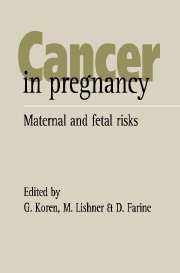Book contents
- Frontmatter
- Contents
- Preface
- List of contributors
- Part I Introduction
- Part II Specific tumors during pregnancy
- 8 Maternal and fetal outcome following breast cancer in pregnancy
- 9 Maternal and fetal outcome following Hodgkin's disease in pregnancy
- 10 Non-Hodgkin's lymphoma and pregnancy
- 11 Maternal and fetal outcome following invasive cervical cancer in pregnancy
- 12 Pregnancy and ovarian cancer
- 13 Malignant melanoma and pregnancy
- 14 Leukemia during pregnancy
- 15 Thyroid cancer and pregnancy
- Part III Fetal effects of cancer and its treatment
- Index
10 - Non-Hodgkin's lymphoma and pregnancy
from Part II - Specific tumors during pregnancy
Published online by Cambridge University Press: 06 July 2010
- Frontmatter
- Contents
- Preface
- List of contributors
- Part I Introduction
- Part II Specific tumors during pregnancy
- 8 Maternal and fetal outcome following breast cancer in pregnancy
- 9 Maternal and fetal outcome following Hodgkin's disease in pregnancy
- 10 Non-Hodgkin's lymphoma and pregnancy
- 11 Maternal and fetal outcome following invasive cervical cancer in pregnancy
- 12 Pregnancy and ovarian cancer
- 13 Malignant melanoma and pregnancy
- 14 Leukemia during pregnancy
- 15 Thyroid cancer and pregnancy
- Part III Fetal effects of cancer and its treatment
- Index
Summary
Non-Hodgkin's lymphoma (NHL) has an age-dependent incidence pattern with a sharp increase in frequency starting in middle life. In contrast, Hodgkin's disease (HD) exhibits a bimodal peak distribution. The first, in early adulthood, is followed by a plateau and a second peak after age 55. These differences in age distributions together with the higher incidence of NHL in young males probably explain the sparsity of reports of NHL associated with pregnancy in comparison with HD. These reports comprise mostly single cases or a very small number of uncontrolled studies. Thus, experience in the management of pregnancy complicated by NHL is limited and whether each of them affects the course of the other is still debated.
A careful review of published cases suggests that aggressive histology NHL is the most common type reported in pregnant patients. This histologic presentation, the possible teratogenicity of some diagnostic methods and the possible benefit of some combined chemotherapy regimens (see below) dictate a limited staging workup during pregnancy. In addition, it is well established that tomographic scans and isotope studies are contraindicated during pregnancy due to potential harm to the fetus. However, in contrast, abdominal ultrasound is safe and useful in pregnancy, while the role and safety of magnetic resonance imaging in the evaluation of pregnant women with NHL are still unclear. Accordingly, it has been suggested that staging should include history, physical examination, routine blood tests bone marrow biopsies, chest X-ray with abdominal shielding and abdominal ultrasound.
- Type
- Chapter
- Information
- Cancer in PregnancyMaternal and Fetal Risks, pp. 116 - 119Publisher: Cambridge University PressPrint publication year: 1996

